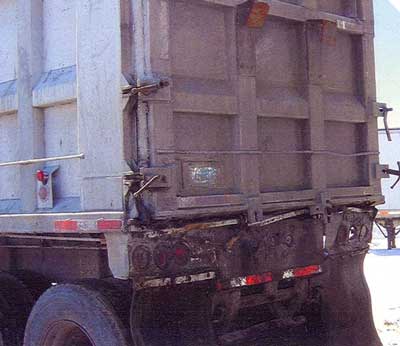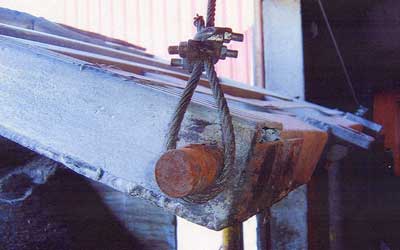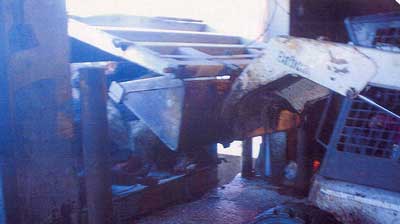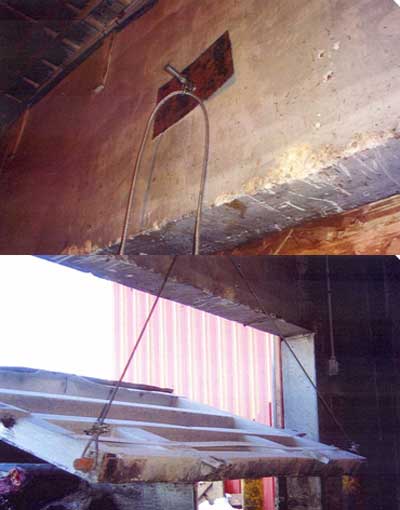Hispanic Butcher Dies After Being Struck By Semi-Trailer Gate
Wisconsin Case Report 05WI001
Summary
On March 1, 2005, a 32-year-old Hispanic butcher (the victim) was struck by the rear gate of a semi trailer dump truck (Figure 1). The crew consisted of the victim and his Hispanic co-worker, the Bobcat operator. The victim entered the semi-trailer to put a chain on a dead cow and the Bobcat operator dragged the dead cow off the semi-trailer using a Bobcat (skid steer) industrial truck. The procedure for chaining dead cows was repeated until the trailer was empty. While Spanish was the victim’s primary language, the victim understood limited English. He could not write or speak English fluently. Spanish was also the Bobcat operator’s primary language. In performing the duties of his job, the victim walked into the semi-trailer under the raised gate of the semi trailer. The victim was exposed to a crushing hazard of the gate each time he entered and exited the trailer. The semi trailer gate was unlatched and moved back to the loading dock. A wire sling was placed around the locking pins on each side of the semi trailer gate (Figure 2) and the gate was raised by using the Bobcat (Figure 3). The gate was maintained in a raised position by the wire sling attached to the semi trailer locking pins and to the attachment point above the door (Figure 4), but there was nothing in place that prevented the slings from slipping off of the locking pins nor was the door blocked open. At the time of the incident, the wire sling slipped off of the pins causing the gate to fall down and the victim was crushed by it. Co-workers found the victim between the gate and the end of the trailer. Four co-workers raised the gate and removed the victim. Management of the company called 911 Emergency Medical Services (EMS) at 2:34 p.m. The first responder was the deputy sheriff arriving at 2:37 p.m. The ambulance crew performed CPR and transported the victim to the local hospital. The victim was pronounced dead at 3:26 p.m. The distance from the scene of the accident to the hospital was approximately 20 miles. FACE investigators concluded that to help prevent similar occurrence, employers should:
- develop, implement, and enforce an effective Lockout/Tagout procedure that addresses the hazards of gravity support of the semi-trailer tailgate.
- ensure that a comprehensive written safety and health program is established that includes training in hazard recognition and procedures that eliminate hazards.
- ensure that all workers who are part of the multi-lingual work force comprehend and follow training instructions in safe work procedures for all tasks to which they are assigned.

|

|

|

|
|
Figure 4. The semi trailer gate maintained in a raised position by the wire sling attached to the semi trailer locking pin and the attachment point above the door.
|
Introduction
On March 1, 2005, a 32-year-old Hispanic butcher (the victim) was stuck by the rear gate of a semi trailer dump truck. The victim died after being struck by the raised overhead gate after the wire sling used to hold the gate up slipped off of the tailgate pin. The WI FACE program learned about the death from the death certificate. In June 2006, the FACE investigator sent a letter to the company requesting an interview. A week later, the FACE investigator followed up with a telephone call to the company and an on-site interview was arranged. Official reports were reviewed.
The company where the incident occurred was an animal bi-products company. The company removes and butchers dead cows and processes hides and skins. The butchered animal parts are used for pet food. The company consisted of 60 employees, 30 were truck drivers. Other employees included laborers/butchers, one lift truck operator, one Bobcat operator, foremen, clerical, and management staff. The workers in the production area were mainly Hispanic. The company had two meat grinders, a hoist, a hide puller, an air compressor, a water heater, a freezer, a Bobcat and a lift truck.
The company was in existence since 1986 and was sold to new owners in 2002. The new company has been in business and unloading cows since that time.
Farmers notified the company when they had a dead cow and a driver was sent to remove it. The cows were removed by hydraulic pullers/winches mounted to the front of the trailer. The dead cows were pulled into the trailers by using the winch. To off-load the dead animals, a chain was tied to the dead cows and attached to the Bobcat bucket and the cow was dragged off the semi-trailer. The rear dump gate of the semi trailer was raised by using a wire sling attached to the pins on either side of the gate. The gate was raised by the bucket of the Bobcat and secured by a 3/4-inch bolt located on the door support (header). The bolt was drilled through the header and attached to a connecting link (Figure 4).
The company did not have a formal training program. The employees (both the victim and the Bobcat operator) were trained on-the-job. Training was conducted by an employee fluent in Spanish as well as English. The victim worked for this company for the past three years.
Back to Top
Investigation
The company had been unloading cows since 2002 when the facility opened under new owners. On the day of the incident, some cows may have frozen and stuck to the bed of the semi-trailer. This caused side-to-side movement of the semi-trailer when the Bobcat operator was removing the frozen cows. The facility unloaded over three trucks per day and takes up to 15 minutes to unload a truck, depending on the number of dead cows. If frozen cows are present, the unloading process takes longer to complete. The exact amount of time varies depending on the number of cows frozen and unfrozen.
The victim walked under the raised gate, hooked the cow with the chain, walked out under the raised gate, and the Bobcat operator pulled the cow to the loading dock. The victim unhooked the cow on the floor of the loading dock and repeated the process for the next cows. The Bobcat operator stated that he did not bump the gate while pulling the cow to the loading dock. He also stated that he does go side to side inside of the semi-trailer dragging the cows out.
One wire rope sling is attached over the pin and the same procedure is done on the other side, but nothing was done to secure the wire ropes. The gate is raised with the two wire rope slings to an attachment point above the door to a 3/4-inch bolt, which is drilled through the door overhead support (header). Evidence suggests that this could cause side-to-side motion and could cause the wire rope slings to slip off of the gate pins sideways.
After the Bobcat operator pulled the last cow off of the trailer, the victim unhooked the chain. The Bobcat operator went to another room and came back, noticing that the gate was down. The victim had been crushed between the gate and the bed of semi-trailer.
The supervisor of the group spoke English and Spanish. The workers speak Spanish primarily, but communicate very limitedly in English. The Bobcat operator notified the Supervisor who contacted EMS.
The employer was not aware of previous incidents in which the gate of the semi-trailer had come down.
Cause of Death
The official cause of death was blunt force trauma to the head causing cerebral hemorrhage.
Recommendations/Discussion
Recommendation #1: Develop, implement, and enforce an effective Lockout/Tagout procedure that addresses the hazards of gravity support of the semi-trailer tailgate.
Discussion: The employer should evaluate all hazards in the workplace. This would take into account the forces of gravity on the tailgate of semi-trailer. Efforts should be made that the semi-trailer tailgate is adequately supported. This can be done by securing the wire rope to the tailgate pins and blocking the tailgate in the upright position. This would eliminate the gravity effect of the tailgate falling down and striking an employee.
Recommendation #2: Ensure that a comprehensive written safety and health program is established that includes training in hazard recognition and procedures that eliminate hazards.
Discussion: The employer did not have a comprehensive safety plan or provide training. The employer should develop, implement and enforce a comprehensive safety program that includes training in hazards present and the standard operating procedures that are to be followed to avoid these hazards. A job safety analysis (JSA) should be conducted and a safe standard operating procedure developed for the loading and unloading procedure. All affected employees should be trained in the new procedure.
Recommendation #3: Ensure that all workers who are part of a multilingual workforce comprehend and follow training instructions in safe work procedures for all tasks to which they are assigned.
Discussion: The employer should enforce a multi-lingual safety-training program. The safety program should be developed at the literacy level of the company’s workforce and in the employee’s primary language. In this case, the safety training was not provided and recognition of safety hazards was not communicated to the employees.
References
- Code of Federal Regulations, 29 CFR 1910.132, Personal Protective Equipment. Washington, D.C.: U.S. Government Printing Office, Office of the Federal Register.
- Code of Federal Regulations, 29 CFR 1910.147, Lockout/Tagout. Washington, D.C.: U.S. Government Printing Office, Office of the Federal Register.
- Code of Federal Regulation, 29 CFR 1910.184, Slings. Washington, D.C.: U.S. Government Printing Office, Office of the Federal Register.
- NIOSH Alert: Preventing Worker Deaths from Uncontrolled Release of Electrical, Mechanical and Other Types of Hazardous Energy. NIOSH 99-110, 1999.
- Technical Report General Characteristics of Wire Rope. St. Joseph, MO: Wire Rope Corporation of America, 30 May 1989.
- The Crosby Group Product Warning: Crosby Clips Warnings and Applications. Tulsa, OK: Crosby Group Inc., 2801 Dawson Rd, Tulsa, OK, Phone: (800) 772-1500, 16 September 2002.
Wisconsin Fatality Assessment and Control Evaluation (FACE) Program
Staff members of the FACE Project of the Wisconsin Division of Public Health, Bureau of Occupational Health, conduct FACE investigations when a machine-related, youth worker, Hispanic worker, highway work-zone death, farmers with disabilities or cultural and faith-based communities work-related fatality is reported. The goal of these investigations is to prevent fatal work injuries studying: the working environment, the worker, the task the worker was performing, the tools the worker was using, the energy exchange resulting in fatal injury and the role of management in controlling how these factors interact.
To contact Wisconsin State FACE program personnel regarding State-based FACE reports, please use information listed on the Contact Sheet on the NIOSH FACE web site. Please contact In-house FACE program personnel regarding In-house FACE reports and to gain assistance when State-FACE program personnel cannot be reached.
